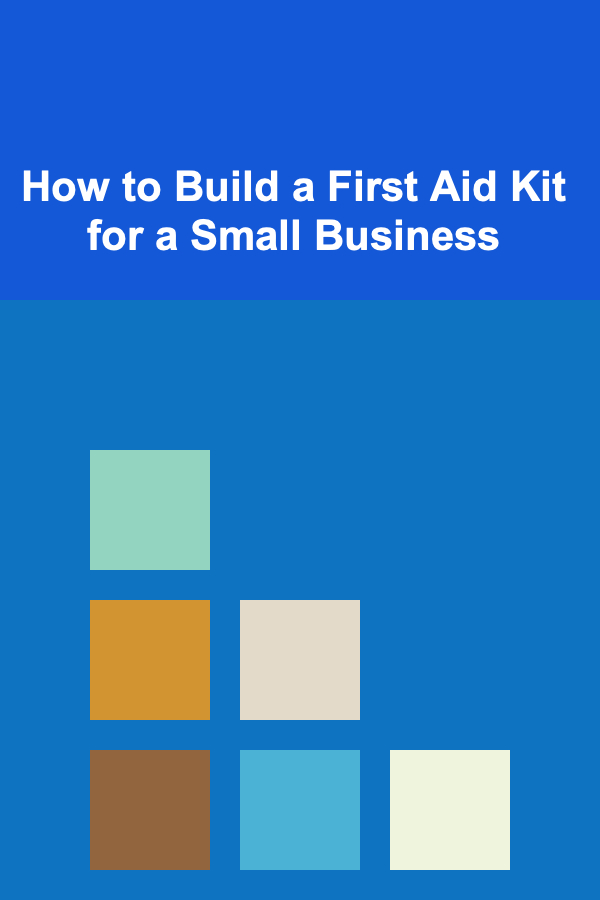
How to Build a First Aid Kit for a Small Business
ebook include PDF & Audio bundle (Micro Guide)
$12.99$9.99
Limited Time Offer! Order within the next:

Creating a well-equipped first aid kit is a fundamental step for any small business aiming to provide a safe and secure environment for its employees, customers, and visitors. Whether you run a retail store, a small office, a workshop, or a café, emergencies can occur unexpectedly, and being prepared to respond effectively can prevent minor injuries from escalating and can even save lives.
This comprehensive article explores in depth how to build an effective first aid kit tailored specifically for a small business setting. It addresses legal requirements, the types of injuries most commonly encountered in small workplaces, the essential supplies to include, best practices for kit maintenance, staff training, and ongoing readiness.
Understanding the Importance of a First Aid Kit in Small Businesses
Why Every Small Business Needs a First Aid Kit
In any workplace, accidents can happen. Small businesses might be perceived as low-risk compared to large industrial operations, but they still face hazards ranging from slips and falls to cuts, burns, or allergic reactions. Having a first aid kit readily available allows immediate response to injuries, which can:
- Minimize the severity of injuries
- Reduce downtime and loss of productivity
- Demonstrate commitment to employee welfare
- Meet legal and regulatory requirements
- Boost employee confidence and morale
The importance of a first aid kit is not only about compliance; it's also about fostering a culture of safety and care within the organization.
Legal and Regulatory Considerations
Before assembling your first aid kit, it is critical to understand the legal obligations for your business location. Different countries and even regions within countries may have specific regulations outlining:
- Minimum first aid supplies required
- The number and training of appointed first aiders
- Documentation and record-keeping of injuries and treatments
For example, in the United States, OSHA (Occupational Safety and Health Administration) provides guidance for workplace first aid provisions but often leaves it to employers to assess the hazards and determine needs. The UK's Health and Safety Executive (HSE) offers more prescriptive guidelines about the contents of first aid kits based on workplace size and risks.
A thorough risk assessment of your business environment is the first step. This assessment should consider:
- The nature of the work performed
- The size of the workforce
- The location and accessibility of emergency services
- The likelihood and types of injuries
This will guide not only the contents of your first aid kit but also the overall first aid strategy for your business.
Assessing Workplace Risks and Injury Types
Common Injuries in Small Businesses
Understanding the typical injuries that might occur in your business helps tailor your first aid kit and training to real needs. Common workplace injuries in small businesses include:
- Cuts and lacerations: Often from handling sharp objects, tools, or broken glass.
- Burns: From hot surfaces, chemicals, or electrical equipment.
- Sprains and strains: Resulting from slips, trips, falls, or manual handling.
- Eye injuries: Caused by chemical splashes, dust, or flying debris.
- Allergic reactions: From food, insect stings, or other allergens.
- Respiratory issues: Exposure to dust, fumes, or smoke.
- Shock or fainting: Due to sudden illness, injury, or environmental factors.
Conducting a Risk Assessment
Conduct a systematic evaluation of your workplace to identify hazards. This can be done using a checklist and by involving employees to gather insights about daily activities and potential risks.
Questions to consider:
- What machinery or tools are used and what injuries might they cause?
- Are there chemicals or substances that pose health risks?
- How many employees and visitors are typically present?
- Are there emergency exits and clear routes for ambulance access?
Your risk assessment should be reviewed regularly, especially if your business activities change or you add new equipment or processes.
Selecting Essential Supplies for the First Aid Kit
Basic Principles of Kit Contents
The first aid kit should be stocked with items that enable prompt treatment of minor injuries and stabilization of more serious conditions until professional help arrives. The kit must be:
- Comprehensive: Covering a variety of injuries based on your risk assessment.
- Accessible: Stored in a clearly marked, easy-to-reach location.
- Well-organized: Containing supplies in an orderly manner for quick use.
- Portable: Easy to carry to the injured person if necessary.
Core Supplies for a Small Business First Aid Kit
Here's a detailed list of essential items, grouped by category:
Wound Care and Dressings
- Adhesive bandages (various sizes): For small cuts and abrasions.
- Sterile gauze pads: To cover and protect wounds.
- Sterile dressings: Larger pads for serious wounds.
- Adhesive tape: To secure dressings in place.
- Antiseptic wipes or solution: For cleaning wounds and preventing infection.
- Antibiotic ointment: To promote healing and prevent bacterial growth.
- Butterfly closures or wound closure strips: For closing minor cuts.
- Hydrogel dressings: For burns or blisters.
Tools and Instruments
- Disposable gloves: To protect the first aider and reduce infection risk.
- Tweezers: For removing splinters or debris.
- Scissors: To cut dressings or clothing.
- Safety pins: To secure bandages or slings.
- Thermometer: To check for fever if illness is suspected.
- CPR face shield or mask: For safe resuscitation efforts.
- Instant cold packs: To reduce swelling and pain from sprains or bruises.
Medications and Other Supplies
- Pain relief tablets: Such as acetaminophen or ibuprofen (note any restrictions or allergies).
- Burn gel or cream: For treating minor burns.
- Eye wash solution: To flush out irritants from eyes.
- Emergency blanket: To prevent shock and maintain body temperature.
- Elastic bandages: For wrapping sprains or strains.
- Splints or finger immobilizers: To stabilize fractures or injuries if possible.
Customizing the Kit Based on Business Needs
Industry-Specific Considerations
Depending on your business type, you may need additional specialized items:
- Food service: Allergy medication (e.g., antihistamines or epinephrine auto-injectors if staff have known allergies).
- Retail or warehousing: Larger supplies for trauma, like tourniquets or hemostatic dressings.
- Beauty salons: More wound care supplies, antiseptics, and eye washes.
- Construction or manufacturing: Advanced supplies for serious injuries and burns.
Quantity and Number of Kits
The size of your workforce and the layout of your business affect how many first aid kits you need. Larger spaces or multiple floors might require several kits to ensure rapid access in an emergency. For very small businesses, one well-stocked kit may suffice, but it must be kept fully stocked and checked regularly.
Storage and Maintenance of the First Aid Kit
Location and Accessibility
- The kit should be placed in a central, easily accessible location known to all employees.
- It should be clearly labeled and kept out of direct sunlight or extreme temperatures to preserve supplies.
- In larger workplaces, consider multiple kits or mobile kits that can be taken to different work areas.
Regular Inspection and Restocking
- Assign responsibility for kit maintenance to a specific person, such as a safety officer or office manager.
- Establish a regular schedule for checking supplies --- at least monthly or after use.
- Replace expired or used items promptly to ensure readiness.
Documentation
- Maintain a log of inspections, restocking activities, and any incidents requiring first aid.
- Documentation helps demonstrate compliance and can identify patterns that may require further safety measures.
Training Employees in First Aid
Why Training Matters
Having a first aid kit is not enough without trained individuals who know how to use it correctly. Training helps:
- Empower employees to respond confidently during emergencies.
- Reduce panic and improve the effectiveness of initial treatment.
- Comply with legal requirements for workplace safety.
Types of Training
- Basic First Aid: Covers treatment of cuts, burns, fractures, and common injuries.
- CPR and AED Training: Essential for life-threatening situations such as cardiac arrest.
- Specialized Training: For industries with unique risks, e.g., handling chemicals or allergens.
Selecting Training Providers
Choose reputable providers that offer certified courses recognized by relevant authorities. Many organizations provide tailored workplace first aid training, including practical exercises and scenario-based learning.
Encouraging a Culture of Safety
Promote first aid training as part of a broader commitment to workplace safety. Encourage regular refresher courses and include first aid awareness in employee orientation programs.
Preparing for Emergency Situations Beyond the First Aid Kit
Emergency Action Plan
A first aid kit is just one part of an overall emergency preparedness strategy. Your business should have a clear Emergency Action Plan (EAP) that includes:
- Emergency contact numbers
- Procedures for serious injuries or medical emergencies
- Evacuation routes and meeting points
- Roles and responsibilities during emergencies
Communication and Reporting
- Ensure all employees know how to summon help quickly.
- Keep a list of nearby medical facilities.
- Establish a procedure for reporting injuries to management and authorities as required.
First Aid Signage
Use clear signage to mark first aid kit locations and emergency exits. This visual aid can save precious seconds during an emergency.
Case Studies: First Aid Kit Implementation in Small Businesses
Case Study 1: Small Retail Store
A boutique clothing store with 10 employees implemented a single first aid kit customized with bandages, antiseptic wipes, cold packs, and allergy medication. They assigned a trained staff member as the first aider. After a minor cut incident, immediate treatment prevented infection and kept the employee productive.
Case Study 2: Café with Allergy Risks
A small café with frequent customers with food allergies stocked epinephrine auto-injectors and trained all employees in recognizing and responding to allergic reactions. This proactive approach enhanced customer safety and trust.
Case Study 3: Workshop with Manual Labor
A woodworking shop with 15 employees stocked additional burn dressings, eye wash stations, and splints. Regular first aid training sessions were held quarterly, and an emergency plan was posted. This preparation helped when an employee suffered a deep laceration, allowing swift stabilization until emergency services arrived.
Conclusion
Building a first aid kit for a small business requires thoughtful planning, a clear understanding of workplace hazards, and ongoing commitment to maintenance and training. A well-prepared first aid kit is an indispensable resource that can reduce the severity of injuries, comply with legal requirements, and foster a culture of safety and care.
By assessing your business needs, selecting appropriate supplies, ensuring easy access, and empowering employees through training, you create a workplace that is ready to handle emergencies with confidence and professionalism. Remember that a first aid kit is a living resource that requires regular attention and updating to remain effective.
Investing in first aid readiness is ultimately an investment in your people---the greatest asset of any small business.
If you want, I can also help you create a detailed checklist or template to start building your own customized first aid kit!
Reading More From Our Other Websites
- [Home Party Planning 101] How to Create a Budget-Friendly Party Decor That Looks Amazing
- [Home Staging 101] How to Stage a Home With an Open Floor Plan for Flow and Function
- [Skydiving Tip 101] Adventure Stories: Real-Life Tales of Unforgettable Skydiving Experiences
- [Organization Tip 101] What Should You Include in Your Home Command Center?
- [Biking 101] The Benefits of Mountain Biking: Why You Should Try It
- [Home Rental Property 101] How to Deal with Landlords About Air Conditioning Issues
- [Personal Care Tips 101] How to Choose the Right Mascara for Your Lash Concerns
- [Stamp Making Tip 101] How to Build a Portable Stamp‑Making Studio on a Budget
- [Home Storage Solution 101] How to Organize Your Closet for Easy Access
- [Home Family Activity 101] How to Create a Family "Acts of Kindness" Challenge

How to Create a Smart School Supply Station for Kids
Read More
How to Prioritize Spending in Your Home Budget for Maximum Savings
Read More
How to Update Your Kitchen with Affordable DIY Projects
Read More
The Ultimate Guide to Saving on Home Renovation Projects on a Budget
Read More
How to Offer Resume Writing Services
Read More
How to Balance Your Macronutrients for Optimal Energy
Read MoreOther Products

How to Create a Smart School Supply Station for Kids
Read More
How to Prioritize Spending in Your Home Budget for Maximum Savings
Read More
How to Update Your Kitchen with Affordable DIY Projects
Read More
The Ultimate Guide to Saving on Home Renovation Projects on a Budget
Read More
How to Offer Resume Writing Services
Read More